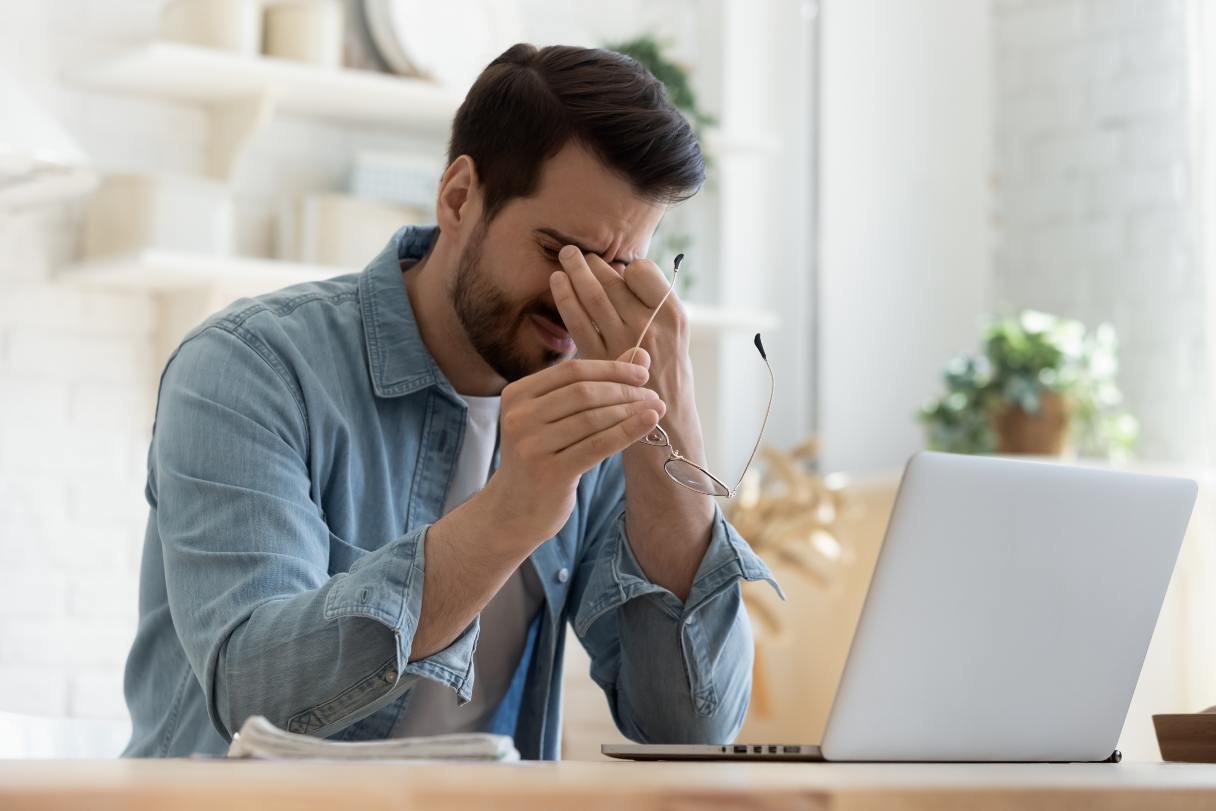Dry, itchy eyes can make you feel very uncomfortable. But understanding what causes eyes to be dry or itchy is the first step toward finding the best vision treatment options for some relief. Symptoms tend to be more common during allergy season as well as during cold weather months — when the air is drier. But dry eyes can also strike most people anytime and anywhere.
What Causes Dry Eyes?
Dry eyes often occur when there's an imbalance between the tears you're producing to lubricate your eyes and how well your eyes are draining those tears.1 When our eyes don't produce enough tears, we may experience a dry, itchy feeling in our eyes, as well as redness and light sensitivity.
The condition can be temporary if caused by allergies or medication, for example; or chronic if it's connected to something more long-term like aging.
Some of the common causes of dry, itchy eyes include:
- Seasonal allergies or year-round allergies or exposure to dry air, wind, or smoke2
- Aging1
- Medications like antihistamines, decongestants and even prescriptions where dry eyes are a side effect1
- Wearing contacts or having refractive surgery2
- Conditions such as eyelid inflammation like blepharitis1
- Eye strain from activities like using a computer or driving for a long time2
- Health conditions like rheumatoid arthritis or diabetes1
- Corneal nerve sensitivity2
Dry Eye Symptoms
The symptoms of dry eye can vary depending on the cause, but typically include:
- Itching3
- Burning or stinging1
- Redness1
- Sometimes painful or sore3
- Light sensitivity2
- Blurry vision2
- Mucus near your eye1
Dry Eye Relief Options
Depending on the cause and severity of your dry eyes, you might consider natural treatments, over-the-counter relief, prescriptions or even surgeries. Below is a list of 20 treatments that might provide relief, depending on the cause of your dry eyes.
Natural treatments for dry eye
For mild cases, simple, natural treatments may help ease dry eye symptoms.
1. Sunglasses
Wear sunglasses when you're outside.1 In addition to protecting your eyes from UV rays, sunglasses also protect you from wind and dust, which can irritate and dry your eyes. Wraparound sunglasses are especially helpful.2
2. Humidifiers
A humidifier adds moisture to the air, which can help your natural tear film to not dry up as quickly.2
3. Warm compresses
Apply a warm, wet compress (like a washcloth) over your closed eyes every day.4
4. Move your monitors
Position your digital screens below eye level to help reduce eye strain.2 When your screen is too high, it can cause you to open your eyes wider, which will make your eyes dry faster.
5. Take frequent breaks
Take frequent breaks when you're working.2 You may be blinking less when you're concentrating (whether it's looking at a monitor or reading a book), which can lead to your eyes feeling dryer.
6. Avoid air blowing directly in your eyes
Try to avoid air getting blown into your eyes in cars and on airplanes, as this can have a drying effect. If you can, direct the vents away from your face.1
7. Avoid smoke
Avoid smoking or being around secondhand smoke.2 Smoke can make dry eyes worse.
8. Drink more water
Sometimes dehydration can contribute to dry eyes.1 Make sure you drink plenty of water every day.
9. Avoid antihistamines
Sometimes antihistamine pills can make dry eyes worse by reducing the tears you produce naturally.4 Talk with your doctor before making any big medication changes.
Over-the-counter relief for dry eye
Sometimes you need to take things a step further and test over-the-counter solutions for your dry eyes.
1. Eye drops
Over-the-counter eye drops called artificial tears can help ease mild symptoms.5 Look for brands that are free of preservatives, since additives might irritate your eyes more.1
2. NSAIDS
Non-steroidal anti-inflammatory medications can sometimes ease some dry eye symptoms.6 But you'll still want to see an eye doctor for further evaluation.
3. Lid scrubs
Lid scrubs can be purchased over the counter.6 Some people use them daily to help keep their eyelids clean, followed by warm compresses.
Prescribed treatments and surgeries for dry eye
Natural remedies and over-the-counter drops can help mild cases. But more severe cases may require a visit to your eye doctor for an eye exam. Your doctor may recommend one of the following prescriptions or surgeries.
1. Prescription eye drops
Your eye doctor may prescribe prescription eye drops.2 The exact brand will depend on what's causing your problem.
Prescription eye drops like Restasis® can help increase tear production.7 This medication can cost hundreds of dollars. The prescription drop Xiidra® is another option. It typically costs more than Restasis®, sometimes $600 or more.7
You might also be prescribed a short-term dose of steroid eye drops to reduce inflammation quickly.6
2. Autologous serum eye drops
Autologous serum eye drops are a very different type of eye drop that might be prescribed to you.6 This is a serum made from your own blood that can replace artificial tears and help reduce inflammation.
3. Specialty contacts
Scleral lens contacts trap moisture and protect your eyes, helping keep them lubricated.6
4. Lacrisert lubricant
For moderate or severe cases, some eye doctors will prescribe Lacrisert®.2 This is an insert put under the lower eyelid that moistens your eye for up to 24 hours. It can cost as much as $600 or more.7
5. Lipiflow dry eye treatment
A common cause of dry eyes is meibomian gland dysfunction, which occurs when glands inside the eyelids become clogged and can't secrete oil.8 Lipiflow treatment can help this issue. The procedure lasts about 12 minutes and uses an applicator to deliver a warm pulse that expresses your glands, restarting oil production. Lipiflow dry eye treatment can cost about $700 to $1,500 a session, though fees can vary by location.9
6. Surgery or plugs to block the tear ducts
Some eye doctors may use tiny plugs made of silicone or gel to block your tear ducts, so your natural tears don't drain as fast.1 In some cases, surgery might be needed to permanently close your tear ducts.
7. IPL treatment
Intense pulsed light (IPL) on the eyelids may help dry eyes by reducing inflammation from dilated blood vessels.6 IPL can cost $412 on average per treatment.
8. Eyelid weights
Other treatments, like weights in the upper eyelids, are also a possibility.10 However, eyelid weights are typically used for people who have facial palsy, which prevents them from blinking regularly, leading to dry eyes.
If you continue to experience persistent dry, itchy eyes, or your symptoms worsen, be sure to schedule an appointment with your eye doctor, who can help determine the cause and recommend appropriate dry eye treatments.
CareCredit Financing for Dry Eye Treatment
Whether you're getting an eye exam or needing eye surgery, the CareCredit credit card can help you pay for care where your insurance leaves off.* Apply today and use our Acceptance Locator to find a vision specialist near you that accepts CareCredit. Continue your wellness journey by downloading the CareCredit Mobile App to manage your account, find a provider on the go, and easily access the Well U hub for more great articles, podcasts, and videos.
Author Bio
Stephanie Dwilson specializes in science journalism, breaking news, and animal health and is a business owner, non-practicing attorney, and writer.







